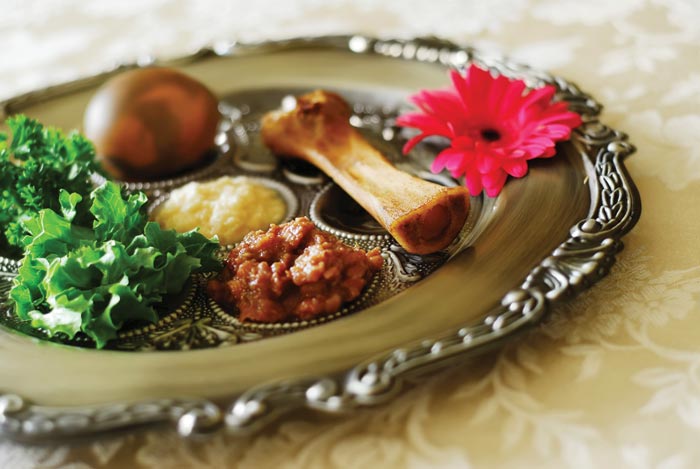Valentine’s Day came and went without trouble or fanfare. My daughter and I exchanged bouquets of red and yellow tulips, and tiny gift cards professing love.
“Let’s spend the day together,” the soon-to-be 17-year-old said. “After all, we’re both alone.”
It was a good day, too, hanging around the house, feeling homey under our comforters after weeks of the flu, then going to see the tear-jerker “Message in a Bottle” and thinking about Paul Newman’s bravery growing old. There are many kinds of love, and this one, between mother and teenage daughter, sweeps all others away.
I was relieved, just as I was in December, when I didn’t have the slightest visceral response to all that black velvet, the fabric of the holiday season. See, I said, I must be a grown up now, immune to the romantic spirit, in black or red.
But then, the next day, I saw a poster advertising an upcoming Purim carnival, and, to put it kindly, I was gone. My thoughts were besotted with Queen Esther and questions I had never considered now overwhelmed me.
Was Esther excited by the beauty pageant, or only playing the game? Did she grow to love Ahasuerus, after he saved her life and that of the Jewish people? Did she ever have children? Was her life full of passion, or merely of duty?
I worried about Esther just like I had about Robin Wright Penn’s Theresa in “Message,” two other women like me wondering about their next best step. It would be unbearable to consider that Esther was like Hillary Clinton, stuck in a loveless marriage even with a man who could perform a few good magic tricks.
Or, on second thought, maybe that wouldn’t be so bad after all. Maybe the better question is: Would I rather be Esther, even in that less-than-satisfying marriage, than be Vashti, brave but out in the world alone?
It is amazing: Here I am, 50 years old, and I’m still a sucker for romance, but now of a different, possibly more complex variety. I fall, if not for messages left in bottles than for stories of sacrifice and bravery in Shushan long ago.
I thought I was over it, grown up, well beyond fairy tales, which means well beyond hope of being swept away by anything, or anyone. But maybe what it means to be grown up is not to whither and die, but to bloom, from deeper roots, anew.
Romance, of course, is dangerous. Jewish women have been warned off it throughout time. In Pearl Abraham’s wonderful “The Romance Reader,” young Rachel Benjamin is deemed suspect by her religious community because she teaches English literature, not Yiddish, in the local Satmar school. Worse yet, she hides out in the public library reading romances.
“A Jew reads only Jewish books and must remain separate,” Rachel’s father tells her, implying reading novels will ruin her chances of making a good marriage.
But what if “Jewish books” are not protection, but instead are provocation?
You have only to start reading rabbinical commentary to appreciate the fire that lies on every page. Aviva Zornberg calls her interpretation of Genesis, “The Beginning of Desire,” and with good reason. “Desire” is the opposite of “passive receptivity,” Zornberg writes, and is the tension that motivates our forebears, our people, our lives, in an effort to understand how to live. Our texts are no dry, prune-like tomes like William Bennett’s morality tales. The Bible and the apocrypha (which includes the Purim megillah) are filled with energy and romance, messiness and yearning. Rachel Benjamin’s father did not want to hear it, but Jewish text is real-life adventure, full stories of men and women who fail and stray.
Most of us know only the sanitized Esther, niece of Mordechai. The eternal virgin. The rabbis call her a “prophet,” the Jewish equivalent of a saint. We’re told her life is only about reparation and salvation.
As a result, Jewish women seeking authoritative role models have fled Esther like the gallows. What use is a role model who had no real life? In the eternal Esther/Vashti duality, Esther out-polls Vashti among girls, but loses among women.
In the new anthology “Which Lilith?” (Joseph Aronson), co-editor Henny Wenkart voices her frustration at the rigidity of Jewish women’s choices. Why must we play the game of either/or, Wenkart asks: Lilith or Eve, Vashti or Esther (the two pairs play remarkably similar roles.)
“There may be love without envy or jealousy…a possibility of going beyond this-or-that to …this-and-this too,” she writes.
Why would I expect less of the Queen of Shushan than I would of Sarah, Rachel, Rebeccah and Leah, or any of the other biblical figures whose stories I have been able, through study and thought, to re-imagine into my life. Why not Esther, real woman and nemesis of Haman?
Maybe Esther didn’t love the king in the beginning. Maybe she never loved him even in the end. But maybe she understood duty, and valor. Or maybe she’s rather be a U.S. senator from New York.
It’s a beginning: Esther, yes, for grownups.
Join Marlene Adler Marks for this Sunday’s “Conversations” program at the Skirball Cultural Center when her guests will be writers Naomi Levy and Sandy Banks; on Tuesday she’s at Barnes & Noble, Santa Monica at 7:30 p.m.
Her website is www.marleneadlermarks.com.
Her e-mail address is wmnsvoice@aol.comHer book, “A Woman’s Voice” is available through Amazon.com.




















 More news and opinions than at a Shabbat dinner, right in your inbox.
More news and opinions than at a Shabbat dinner, right in your inbox.